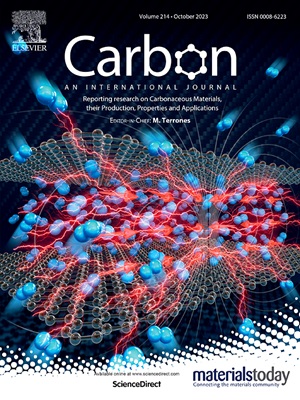Functionalized graphene microspheres for high volumetric energy density supercapacitors
IF 10.5
2区 材料科学
Q1 CHEMISTRY, PHYSICAL
引用次数: 0
Abstract
The development of electrode materials with high packing density and superior volumetric performance is crucial to address the growing demand for compact supercapacitors in wearable electronics and electric vehicles. However, the low packing density of graphene limits its volumetric capacitance. To overcome this challenge, functionalized graphene microspheres (FGR) were synthesized through processes such as ozone oxidation, H2O2 etching, CNT incorporation, spray drying, and carbonization of graphene oxide ribbons (IGOR) with abundant edge sites. The resulting FGR provides numerous active sites, efficient electron and ion transport pathways, stable oxygen-containing functional groups, and a compact structure. These properties enable FGR to achieve high volumetric capacitance and excellent rate performance (442.8 and 308.0 F cm−3 at 1 and 100 A g−1, respectively), high mass loadings (12 mg cm−2) and packing density (1.02 g cm−3). FGR-assembled symmetric supercapacitors (FGR//FGR) deliver a high volumetric energy density of 30.2 W h L−1 at 120.9 W L−1. These features make FGR-based supercapacitors highly relevant for industrial applications, including portable electronics, electric vehicles, and grid energy systems. The scalable synthesis approach and robust design further emphasize their potential for widespread industrial adoption.

求助全文
约1分钟内获得全文
求助全文
来源期刊

Carbon
工程技术-材料科学:综合
CiteScore
20.80
自引率
7.30%
发文量
0
审稿时长
23 days
期刊介绍:
The journal Carbon is an international multidisciplinary forum for communicating scientific advances in the field of carbon materials. It reports new findings related to the formation, structure, properties, behaviors, and technological applications of carbons. Carbons are a broad class of ordered or disordered solid phases composed primarily of elemental carbon, including but not limited to carbon black, carbon fibers and filaments, carbon nanotubes, diamond and diamond-like carbon, fullerenes, glassy carbon, graphite, graphene, graphene-oxide, porous carbons, pyrolytic carbon, and other sp2 and non-sp2 hybridized carbon systems. Carbon is the companion title to the open access journal Carbon Trends. Relevant application areas for carbon materials include biology and medicine, catalysis, electronic, optoelectronic, spintronic, high-frequency, and photonic devices, energy storage and conversion systems, environmental applications and water treatment, smart materials and systems, and structural and thermal applications.
 求助内容:
求助内容: 应助结果提醒方式:
应助结果提醒方式:


